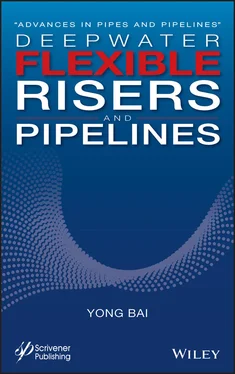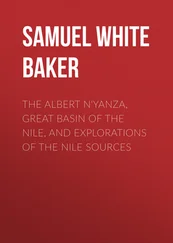3 Chapter 3 Figure 3.1 Structure of flexible pipe. Figure 3.2 Cylindrical mathematical parameters definition. Figure 3.3 Helix mathematical parameters definition. Figure 3.4 Pressure armor cross section profile. Figure 3.5 Kinematic Coupling at RP-2. Figure 3.6 Meshing of the flexible pipe model. Figure 3.7 Kinetic energy/internal energy curve. Figure 3.8 Artificial strain energy/strain energy curve. Figure 3.9 Model of pressure armor layer. Figure 3.10 Mises stress of Z-shaped section. Figure 3.11 Pressure-maximum von Mises stress curve. Figure 3.12 Pressure-axial displacement curve. Figure 3.13 Pressure-radial displacement curve. Figure 3.14 Computer design flowchart of pipe section.
4 Chapter 4 Figure 4.1 Linear-longitudinal profile. Figure 4.2 Contact pressures between layers mechanical model of pressure armor l... Figure 4.3 Pressure armor profile-principal outline. Figure 4.4 Contact pressure and equivalent radii. Figure 4.5 Contraction and elongation for a representative pitch length of tensi... Figure 4.6 Radial loading condition of tensile armor layer. Figure 4.7 Pressure armor-parameterized cross-section (lengths in millimeters an... Figure 4.8 Pressure armor’s load and boundary conditions. Figure 4.9 Pressure armor mesh. Figure 4.10 Strain and kinetic energies against load. Figure 4.11 Pressure against radial displacements for two representative points. Figure 4.12 Steel stress-strain relationship. Figure 4.13 HDPE stress-strain relationship. Figure 4.14 Reference point at the end surfaces. Figure 4.15 Interlayered structure mesh. Figure 4.16 Strain and kinetic energies. Figure 4.17 Tensile force comparison. Figure 4.18 Mises stress of pressure armor from FEM. Figure 4.19 Points selected on the pressure armor external surface for contact p... Figure 4.20 Tensile force comparison. Figure 4.21 Contact pressure between pressure armor and inner tensile armor laye... Figure 4.22 Contact pressure between tensile armor layers. Figure 4.23 Mises stress—outer layer of wires. Figure 4.24 Strain and stress distribution for outer tensile armor layer. Figure 4.25 Mises stress comparison for inner tensile armor layer. Figure 4.26 Mises stress comparison for outer tensile armor layer. Figure 4.27 Tensile strength comparison for the pipe subjected to pure tension a... Figure 4.28 MSFP-based reinforced longitudinal profile. Figure 4.29 Tensile force comparison.
5 Chapter 5 Figure 5.1 Typical carcass profile. Figure 5.2 Typical pressure armor. Figure 5.3 Flow chart of design procedure.Figure 5.4 Mathematical parameters definition.Figure 5.5 Catenary configuration for the tension design.Figure 5.6 Detailed geometry of FE model.Figure 5.7 Burst failure mode of flexible pipe.Figure 5.8 Tension failure mode of flexible pipe.Figure 5.9 Collapse failure moment.
6 Chapter 6Figure 6.1 Reference systems for toroid surface.Figure 6.2 Cross-section of helical layer.Figure 6.3 Darboux frame.Figure 6.4 Micro-section of helical wire.Figure 6.5 The sliding mechanism model.Figure 6.6 The axial displacement of beam.Figure 6.7 The axial force of beam.Figure 6.8 The axial force of helical wire.Figure 6.9 The axial force of helical wire.
7 Chapter 7Figure 7.1 Pipe coiled in the reel drum.Figure 7.2 Buckling failure of MSFP.Figure 7.3 Pipe mechanics analysis in reeling.Figure 7.4 Crosssection of MSFP.Figure 7.5 MSFP with partly outer sheath peeling off.Figure 7.6 Stress-strain curves of HDPE.Figure 7.7 Stress-strain curves of steel strip.Figure 7.8 Tensile test of MSFP.Figure 7.9 Tension-extension curves of two specimens.Figure 7.10 Diagrammatic sketch of bending machine.Figure 7.11 Moment-curvature curves of two specimens.Figure 7.12 MFSP specimen before and after bending.Figure 7.13 Fitting tension-extension curve.Figure 7.14 Fitting bending-curvature curve.Figure 7.15 The global model of reeling operation.Figure 7.16 The local direction of the beam element.Figure 7.17 Mesh condition of the global model.Figure 7.18 Load and boundary condition of the global model.Figure 7.19 The final deformation of the global model.Figure 7.20 SF1 of the pipeline.Figure 7.21 SF2 of the pipeline.Figure 7.22 SF3 of the pipeline.Figure 7.23 A picked path for the pipeline.Figure 7.24 SF1 along the path.Figure 7.25 Contour plot of SM2 along the path.Figure 7.26 SM2 along the path.Figure 7.27 Contour plot of SM3 along the path.Figure 7.28 SM3 along the path.Figure 7.29 SF1 along the path in different coiling drum diameter.Figure 7.30 SM3 along the path in different coiling drum diameter.Figure 7.31 SM2 along the path in different coiling drum diameter.Figure 7.32 SF1 along the path in different sinking distance.Figure 7.33 SM3 along the path in different sinking distance.Figure 7.34 SM2 along the path in different sinking distance.Figure 7.35 SF1 along the path in different reeling length.Figure 7.36 SM3 along the path in different reeling length.Figure 7.37 SM2 along the path in different reeling length.Figure 7.38 The defined distance.Figure 7.39 SF1 along the path in different location of the bearing plate.Figure 7.40 SM3 along the path in different location of the bearing plate.Figure 7.41 SM2 along the path in different location of the bearing plate.
8 Chapter 8Figure 8.1 Bonded flexible pipe (Antal et al., 2003) [1].Figure 8.2 Production and gas lif hoses on the Heidrun TLP (Antal et al., 2003) ...Figure 8.3 Typical cross-section of an unbonded flexible pipe (Zhang et al., 200...Figure 8.4 General arrangement for local curvature analysis at the bellmouth or ...Figure 8.5 Mooring and riser system design (Seymour et al., 2003) [7].Figure 8.6 Overview of riser system interface design (Seymour et al., 2003) [7].Figure 8.7 Water injection flexible pipe technology limits (Remery et al., 2004)...
9 Chapter 9Figure 9.1 Flexible riser configurations. [1]Figure 9.2 Configuration of lazy-wave riser.Figure 9.3 Lazy-wave riser configuration.Figure 9.4 Force sketch of a differential element of suspended riser.Figure 9.5 Force sketch of a differential element of boundary-layer segment.Figure 9.6 Force sketch of a differential element of riser laid on seabed.Figure 9.7 Flow chart of numerical calculation.Figure 9.8 Sketch of OrcaFlex Model.Figure 9.9 Comparison of lazy-wave configurations.Figure 9.10 Comparison of lazy-wave tensions.Figure 9.11 (a) Comparison of lazy-wave bending moments. (b) Comparison of bendi...Figure 9.12 (a) Comparison of lazy-wave shears. (b) Comparison of shears in TDP.Figure 9.13 Bending moment with the variation os seabed.Figure 9.14 Shear with the variation of seabed.Figure 9.15 Inclination angle at TDP with the variation of seabed stiffness.Figure 9.16 Maximum embedment with the variation of seabed stiffness.Figure 9.17 Lazy-wave configuration with the variation of hang-off inclination a...Figure 9.18 Tension with the variation of hang-off inclination angle.Figure 9.19 Bending moment with the variation of hang-off inclination angle.Figure 9.20 Shear with the variation of hang- off inclination angle.Figure 9.21 Lazy-wave configuration with the variation of buoyancy section lengt...Figure 9.22 Tension with the variation of buoyancy section length.Figure 9.23 Bending moment with the variation of buoyancy section length.Figure 9.24 Shear with the variation of buoyancy section length.
10 Chapter 10Figure 10.1 Configuration of steep wave riser.Figure 10.2 Steep wave riser configuration.Figure 10.3 Forces acting on the touch-down segment.Figure 10.4 Forces acting on the touch-down segment.Figure 10.5 Flow chart of numerical calculation.Figure 10.6 Comparison of steep-wave configurations.Figure 10.7 Comparison of steep-wave tensions.Figure 10.8 Comparison of steep-wave bending moments.Figure 10.9 Comparison of steep-wave shear forces.Figure 10.10 Comparison of steep-wave shears near DP.Figure 10.11 Comparison of steep-wave shears near LP.Figure 10.12 Steep wave configuration with the variation of buoyancy segment’s e...Figure 10.13 Tension with the variation of buoyancy segment’s equivalent outer d...Figure 10.14 Bending moment with the variation of buoyancy segment’s equivalent ...Figure 10.15 Shear force vs. buoyancy equivalent outer diameter.Figure 10.16 Steep wave configuration with the variation of buoyancy segment len...Figure 10.17 Tension with the variation of buoyancy segment length.Figure 10.18 Bending moment with the variation of buoyancy segment length.Figure 10.19 Shear force with the variation of buoyancy segment length.Figure 10.20 Steep wave configuration with the variation of buoyancy segment loc...Figure 10.21 Tension vs. buoyancy segment location.Figure 10.22 Bending moment vs. buoyancy segment location.Figure 10.23 Shear force vs. buoyancy segment location.Figure 10.24 Steep wave configuration vs. current velocity.Figure 10.25 Tension vs. current velocity.Figure 10.26 Bending moment vs. current velocity.Figure 10.27 Shear force with the variation of current velocity.
Читать дальше












